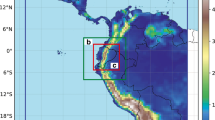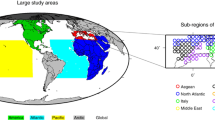Summary
Comparisons between observed and modelled values of surface temperature, surface precipitation and 500 hPa height for the current climate were made for the southeast United States. Daily values and analyses pertinent to impact assessment, were emphasized. For the model, the time-independent 10-year series of values developed by the Geophysical Fluid Dynamics Laboratory general circulation model were used. Observations were drawn from records for various stations and decades within the model grid-cell. Cumulative frequency distributions of temperature indicated both more clustering close to the mean and greater extremes for the model. The model reproduced the seasonal cycle of day-to-day temperature variability, but introduced a phase shift of about four months. One result was an apparent overabundance of hot spells in the model results. For precipitation the model indicated twice as many raindays as were observed, about the same number of days when precipitation exceeded 5 mm, and fewer days with amounts exceeding 10 mm, effectively decreasing the probability of heavy precipitation while enhancing annual totals. In winter the model appeared to represent the results from an aggregation of stations within the grid-cell, but in summer it was closer to individual station results. The model reproduced the seasonal cycle in the height and standard deviation of the 500 hPa surface, with a damped amplitude in both cases.
Similar content being viewed by others
References
Chen, R. E., Robinson, P. J., 1991: Generating scenarios of local surface temperature using time series methods.J. Climate 4, 723–732.
COHMAP Members, 1988: Climatic changes of the last 18,000 years: Observations and model simulations.Science 241, 1043–1052.
Grotch, S. L., 1988:Regional Intercomparisons of General Circulation Model Predictions and Historical Climate Data. Publication NBB-0084. Washington DC: U.S. Department of Energy, 291 pp.
Grotch, S. L., MacCracken, M. C., 1991: The use of general circulation models to predict regional climate change.J. Climate 4, 286–303.
Hatch, W. L., 1983:Selective Guide to Climatic Data Sources. Asheville, NC: National Climate Data Center.
Kalkstein, L. S. (ed.), 1991:Global Comparisons of Selected G C M Control Runs and Observed Climate Data. Washington DC: U.S. Environmental Protection Agency, 251 pp.
Kalnay, E., Jenne, R., 1991: Summary of the NMC/NCAR Reanalysis Workshop of April 1991.Bull. Amer. Meteor. Soc. 72, 1897–1904.
Karl, T. R., Wang, W.-C., Schlesinger, M. E., Knight, R. W., Portman, D., 1990: A method of relating general circulation model simulated climate to the observed local climate. Part I: Seasonal statistics.J. Climate 3, 1053–1079.
Kim, J.-W., Chang, J.-T., Baker, N. L., Wilks, D. S., Gates, W. L., 1984: The statistical problem of climate inversion: Determination of the relationship bewteen local and large-scale climate.Mon. Wea. Rev. 112, 2069–2077.
Manabe, S., Broccoli, A. J., 1990: Mountains and arid climates of middle latitudes.Science 247, 192–195.
Robinson, P. J., Finkelstein, P. L., 1991: The development of impact-oriented climate scenarios.Bull. Amer. Meteor. Soc. 72, 481–490.
Robinson, P. J., Henderson, K. G., 1992: Precipitation events in the south-east United States of America.Int. J. Climatol. 12, 701–720.
Samel, A. N., 1992: Scenario development for the northeast United States 500 millibar height field. Ph.D. Dissertation, Department of Geography, University of North Carolina, Chapel Hill, NC, 144 pp.
Santer, B. D., Wigley, T. M. L., 1990: Regional validation of means, variances, and spatial patterns in general circulation model control runs.J. Geophys. Res. 95, 829–850.
Author information
Authors and Affiliations
Additional information
With 9 Figures
Rights and permissions
About this article
Cite this article
Robinson, P.J., Samel, A.N. & Madden, G. Comparisons of modelled and observed climate for impact assessments. Theor Appl Climatol 48, 75–87 (1993). https://doi.org/10.1007/BF00864915
Received:
Revised:
Issue Date:
DOI: https://doi.org/10.1007/BF00864915




